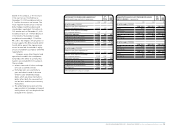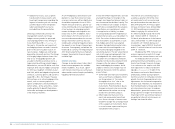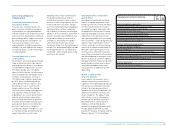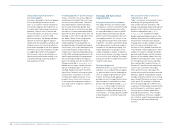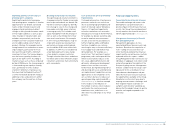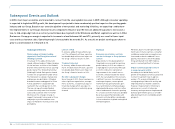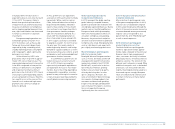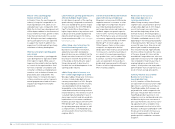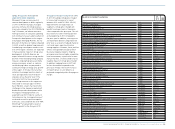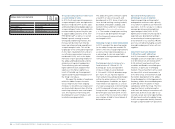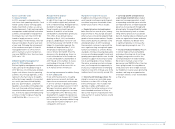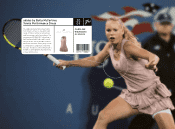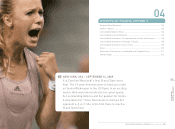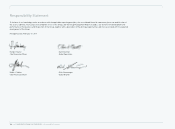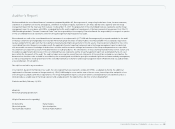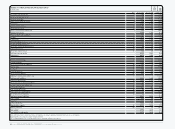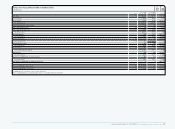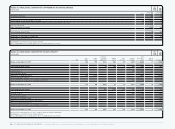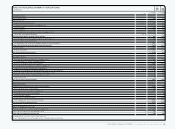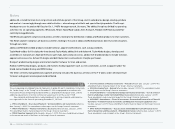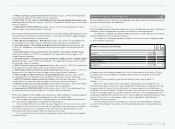Reebok 2009 Annual Report Download - page 165
Download and view the complete annual report
Please find page 165 of the 2009 Reebok annual report below. You can navigate through the pages in the report by either clicking on the pages listed below, or by using the keyword search tool below to find specific information within the annual report.
GROUP MANAGEMENT REPORT – FINANCIAL REVIEW Subsequent Events and Outlook 161
Excess cash to be used
to reduce net debt
In 2010, we expect continued positive
cash flows from operating activities. Cash
will be used to finance working capital
needs, investment activities, as well as
dividend payments. Tight working capital
management and disciplined investment
activities are expected to help optimise
the Group’s free cash flow in 2010. We
intend to largely use excess cash to
further reduce net borrowings, which we
forecast to be below the prior year level
at year-end. Following the achievement
of our medium-term goal of financial
leverage below 50% in 2009, we now
aim to maintain a ratio of net borrow-
ings over EBITDA of less than two times
(2009 ratio: 1.2).
Efficient liquidity management in
place for 2010 and beyond
Efficient liquidity management continues
to be a priority for the adidas Group in
2010. We focus on continuously anticipat-
ing the cash inflows from the operating
activities of our Group segments, as this
represents the main source of liquidity
within the Group. Liquidity is forecasted
on a multi-year financial and liquidity
plan on a quarterly basis. Long-term
liquidity is ensured by continued positive
free cash flows and sufficient unused
committed and uncommitted credit facili-
ties. In 2010, we expect limited financing
activities in order to replace maturing
credit facilities see Treasury, p. 128.
Management to propose
dividend of € 0.35
In light of the strong cash flow generation
in 2009 and the significantly reduced
level of net borrowings, Management has
decided to change its dividend policy.
Going forward, we intend to pay out
between 20 and 40% of net income
attributable to shareholders (previously:
15 to 25%). At our Annual General
Meeting on May 6, 2010, we intend to
propose a dividend per share of € 0.35
for the financial year 2009 (2008: € 0.50).
Subject to shareholder approval, the
dividend will be paid on May 7, 2010.
The proposal represents a payout
ratio of 30% for 2009 (2008:15%). The
decrease in the dividend per share is a
result of the decline in the Group’s net
income attributable to shareholders in
2009. Based on the number of shares
outstanding at the end of 2009, the
dividend payout will decrease 24% to
€ 73 million (2008: € 97 million).
Increasing momentum for adidas Group
in 2011 and beyond
In line with the projections of leading
global economic research institutes, we
expect the macroeconomic environment
in 2011 to continue its gradual recovery
after the severe global recession of 2009.
We expect economic growth to be sup-
ported by accelerating private consump-
tion compared to 2010. We forecast this
development to support the operational
performance of our Group in 2011. Under
this assumption, we project adidas Group
sales and net income to improve in 2011
compared to 2010 levels.
Key goals for long-term success
In addition, the Group will continue to
work towards reaching our priority goals
to achieve long-term sustainable share-
holder value creation. These include:
Expand presence in emerging mar-
kets: Over the last several years, emerg-
ing economies in Asia, Europe and Latin
America have consistently outperformed
growth of more mature markets. Despite
the economic backlash suffered in some
emerging markets in 2009, we believe
these markets continue to represent the
most significant long-term growth oppor-
tunity to our industry as a whole. Rising
standards of living, increasing disposable
income, positive demographic trends and
growing sports participation rates should
continue to support increasing consump-
tion of sporting goods in these markets.
Therefore, assuming constant exchange
rates, our Group sees the opportunity to
increase our representation in emerging
markets to over 40% of Group sales in the
medium term from currently around 35%.
Intensify controlled space focus: We
intend to increase our controlled space
initiatives to at least 35% of Group sales
in the coming years. This includes new
openings of adidas and Reebok own-
retail stores, the further extension of our
mono-branded store base in China, as
well as new shop-in-shop initiatives with
retail partners in several markets around
the world.
Leverage growth and operational
scale through to bottom line: A higher
exposure to emerging markets as well
as expanding controlled space activities
are important levers to improving brand
presence, increasing sell-through and
driving higher Group profitability. In addi-
tion, we continuously work on stream-
lining internal processes to accelerate
decision-making, reduce complexity and
make our organisation leaner and more
efficient. Therefore, we believe there
is significant potential to increase the
Group’s operating margin to over 11%.
Increase financial flexibility: We aim
to further improve financial flexibility
and reduce financing risk of our Group
by largely using excess cash for the
continued reduction of net borrowings.
We strive to maintain a ratio of net
borrowings over EBITDA of less than two
times going forward. A strong balance
sheet and a lower level of debt increase
our flexibility to realise value-generating
medium- and long-term opportunities
in the best interests of our shareholders
as they arise.


